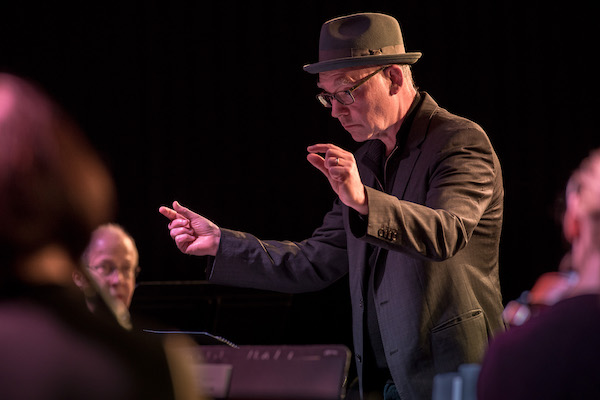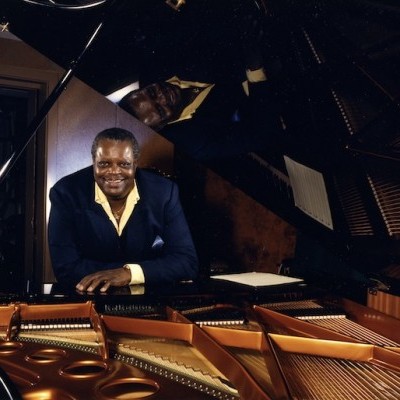Dec 9, 2025 12:28 PM
In Memoriam: Gordon Goodwin, 1954–2025
Gordon Goodwin, an award-winning saxophonist, pianist, bandleader, composer and arranger, died Dec. 8 in Los Angeles.…

Wayne Horvitz conducts the Seattle Modern Orchestra during the Earshot Jazz Festival, which ran Oct. 4–Nov. 6 in Seattle.
(Photo: Daniel Sheehan/Earshot Jazz)Seattle’s Earshot Jazz Festival, a five-week fall marathon known for forward-looking programming, presented 56 concerts this year that included sets by pianists Kris Davis, Marilyn Crispell and Chick Corea; drummer and composer Tyshawn Sorey; and Bay Area vibraphonist Sasha Berliner, among others. But the festival also highlighted Seattle’s vibrant jazz scene, a reminder that a healthy jazz community thrives not just from A-list visitors, but from an infrastructure of strong ensembles, teachers and players.
Standouts included veteran saxophonist and trumpeter Jay Thomas, who served as festival artist-in-residence; the Seattle Modern Orchestra, a contemporary classical ensemble celebrating its 10th anniversary; and the Seattle Repertory Jazz Orchestra, marking its 25th year at at the Kirkland Performance Center. Thomas, 69, is a local treasure hailed by DownBeat as a Talent Deserving Wider Recognition when he was just 17 and who recorded as a young man with James Moody and Cedar Walton. For Earshot, Thomas performed with a cohort of hard-driving Japanese artists in a bop ensemble called the East West Alliance, which included saxophonists Yasuhiro Kohama and Atsushi Ikeda, pianist Yuuki Hirati, drummer Daisuke Kurata, and Seattle bass stalwart Phil Sparks, with the added attraction of Maya Hatch, a vocalist who grew up in Seattle and now works in Japan.
EWA performed at Hatch’s alma mater with the Roosevelt High School Jazz Band, a four-time winner of Jazz at Lincoln Center’s Essentially Ellington competition. But the high-school show was just a warmup for a turn at Town Hall, where this swinging trans-Pacific outfit showcased Thomas’ ineffable abandon on his loping “Second And Union,” which references the address of The Vault, a historic ’60s Seattle club; Ikeda’s thunderous, Coltrane-like “His Way Of Life”; and Hatch’s funky backbeat on her composition, “Let Yourself Be Free.”
Thomas normally plays with the SRJO, but was too busy with EWA to make its Earshot show. The SRJO was co-founded by Clarence Acox, the recently retired director of Seattle’s other award-winning student group, the Garfield High School Jazz Band, and University of Washington saxophone instructor Michael Brockman. For a quarter-century, the group has educated and entertained audiences with classic repertoire by likes of Fletcher Henderson and Duke Ellington, as well as presenting new work by guest artists such as Anat Cohen and Maria Schneider. For Earshot, the band played a thematic program titled “Jazz of the Harlem Renaissance” that highlighted the band’s appropriately zesty, staccato touch with Henderson and intimate understanding of elegant Ellingtonia. In the end, however, the naughty, nervous mood of the Harlem Renaissance did not come through so much as svelte ballroom swing. The insertion of lectures into the show didn’t help much either.
The festival always has embraced improvised music that falls outside a strict definition of jazz, so it made sense to invite the SMO, founded 10 years ago by composer Julia Tai, originally from Taiwan, and French-born composer Jeremy Jolley, who met at UW. An ensemble with shifting personnel, the 10-person lineup at Earshot featured familiar faces from the local contemporary music scene: flute virtuoso Paul Taub, formerly an instructor at Cornish College of the Arts, where the music program is directed by another performer who played that night, reed ace James Falzone; bassist Abbey Blackwell, a regular at the city’s avant-garde Racer Sessions; and new-music pianist Cristina Valdes.
SMO’s delectable, eclectic program at Town Hall included Anthony Braxton’s sad, other-worldly “Composition No. 56 (Creative Orchestra),” featuring young alto saxophone star Darius Jones, who also contributed his unsettling 2018 protest piece, “LawNOrder.” Drummer Sorey, who gave an intense festival performance with his own group (as did Jones), was represented by a quiet, meditative piece, “Violin And Glockenspiel In Memoriam Muhal Richard Abrams.” The set peaked with a premiere of “Vagabond: Constructions For Chamber Orchestra And Improvisers,” by Wayne Horvitz, who took turns with Tai at the podium. She conducted the written parts and he gave conduction signals for the rest, in the manner of Horvitz’s great influence and former bandmate, Butch Morris.
It was a beautiful piece, with sonic sunlight glinting through splintered reeds and strings. Since moving to Seattle in 1988, Horvitz has become the very emblem of what it means to participate generously in a local scene—playing, composing, leading bands, instigating projects and even co-owning a local club, The Royal Room. Along with Thomas, the SRJO and SMO, Horvitz is part of the bones of a Seattle scene that supports the Earshot Jazz Festival. DB

Goodwin was one of the most acclaimed, successful and influential jazz musicians of his generation.
Dec 9, 2025 12:28 PM
Gordon Goodwin, an award-winning saxophonist, pianist, bandleader, composer and arranger, died Dec. 8 in Los Angeles.…

Nov 13, 2025 10:00 AM
For results of DownBeat’s 90th Annual Readers Poll, complete with feature articles from our December 2025 issue,…

Flea has returned to his first instrument — the trumpet — and assembled a dream band of jazz musicians to record a new album.
Dec 2, 2025 2:01 AM
After a nearly five-decade career as one of his generation’s defining rock bassists, Flea has returned to his first…

To see the complete list of nominations for the 2026 Grammy Awards, go to grammy.com.
Nov 11, 2025 12:35 PM
The nominations for the 2026 Grammy Awards are in, with plenty to smile about for the worlds of jazz, blues and beyond.…

“It’s a pleasure and an honor to interpret the music of Oscar Peterson in his native city,” said Jim Doxas in regard to celebrating the Canadian legend. “He traveled the world, but never forgot Montreal.”
Nov 18, 2025 12:16 PM
In the pantheon of jazz luminaries, few shine as brightly, or swing as hard, as Oscar Peterson. A century ago, a…